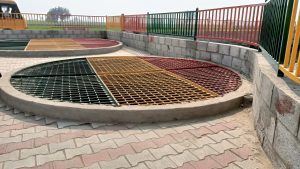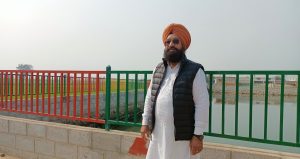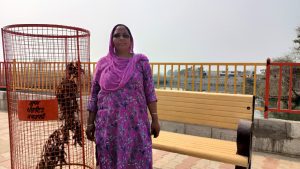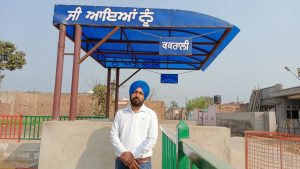Rupnagar, July 26 2021
With the support of the District administration, Kakrali village in Morinda Block of Rupnagar District has set up a system using Thapar technology that treats wastewater from 271 households. Kakrali has a population of 1534 individuals. Prominent in the village is a pond that previously, was filled with wastewater that came from households. It created a bad stench and during rainy seasons, the dirty water would overflow onto the village paths, making a mess and preventing commuters from passing that way. But now the story is different.
Gearing up, taking possible action:
The community has been aware of the Swachh Bharat Mission (Grameen) campaign. Having some exposure visits and interaction with the Panchayati Raj department they understood the relevance and impact of technology devised by Thapar Engineering College, Patiala and wanted to set up a system to manage their wastewater using this technology. In 2018, digging of the ponds began to increase the capacity of the pond. To this, chambers and wells were constructed, the estimated cost of the project being Rs. 35 lakhs.
How does it work?
• Screening chamber: Sewage water from all the households is collected in the screening chamber where floating materials (solid waste, plastic) are separated. Screening chamber is further connected to the digestion well.
• Digestion Well (Well 1): Water revolves in circular motion (clockwise) due to which solid materials settle down in the base while the liquid floats.
• Skimming tank (Well 2): In this tank the motion of the water is anti-clockwise, liquids (oil, water) present in the water get separated.
• Stabilization tank (Well 3): This is the third well, known as the stabilization tank and almost treated water is collected in this.
• Oxidation Pond: Water from the Stabilization tank is then transferred to the Oxidation pond. The main function of the oxidation pond is to treat wastewater through the interaction of sunlight, bacteria, and algae. Algae grow using energy from the sun and carbon dioxide and inorganic compounds released by bacteria in water. Thereafter, the water is transferred and used for agricultural purposes through perforated pipes which are embedded in the soil and carry wastewater to agricultural fields.
Operation and maintenance:
It has been noticed that the bad odour decreases as water reaches the storage pond. The plant requires cleaning and maintenance at different levels which is supported by MGNREGA and Youth Club of the district which extends support for cleaning the screening chamber and wells consistently so that the process is sustained. The site has been beautifully constructed and has turned into a park where children engage in games and recreational activities while adults take a stroll or spend time, in sharp contrast to the situation earlier when they could not event pass by that way.
Residents speak about the impact of the initiative:
Sher Singh, Kakrali (resident): Looking at the condition of the pond, I feel extremely content. My wife is currently the Sarpanch of the village and this initiative has helped her to engage people towards upgrading the village. I was glad to hear from the farmers that no extra manure or chemicals were added to crops this time.
Rajinder Kaur, Social worker: This approach used to clean the pond and use water for agricultural purposes is remarkable. I recall that earlier when my relatives visited us and the small kids wanted to visit the pond, we were unable to stand near it. I am delighted to see a clean and healthy environment in the village.
Buta Singh, Farmer: This liquid Waste Management plant has become a ray of hope for the farmers. Wastewater is not only treated but it also reaches the agricultural fields and helps sustain the quality of crops. Through direct connectivity of pipeline to the pond approximately 70 acres of the land can be irrigated, and more than 15 farmers are benefitting from the same. In fact, earlier we used to use an additional 3 sacks of urea to fertilize our fields. Now however, we use just one sack. The water has organic qualities, and this has enhanced our credibility towards this initiative.
Gurwinder Singh, Chairman Marker Committee: “I am happy with the efforts taken by our Gram Panchayat towards getting the sewage water cleaned through this project. I want to extend my support towards this initiative. The pond has become the pride of our village and I strongly recommend other GPs to adopt a similar initiative.”
- HOME
- India
- National
- States
- Andaman and Nicobar Islands
- Andhra Pradesh
- Arunachal Pradesh
- Assam
- Bihar
- Chhattisgarh
- Dadra and Nagar Haveli and Daman & Diu
- Delhi
- Goa
- Gujarat
- Jharkhand
- Karnataka
- Kerala
- Ladakh
- Lakshadweep
- Madhya Pradesh
- Maharashtra
- Manipur
- Meghalaya
- Mizoram
- Nagaland
- Odisha
- Puducherry
- Rajasthan
- Sikkim
- Tamil Nadu
- Telangana
- Tripura
- Uttar Pradesh
- Uttarakhand
- West Bengal
- North India
- Agriculture
- Lifestyle
- Entertainment
- Education
- Language:

 हिंदी
हिंदी






